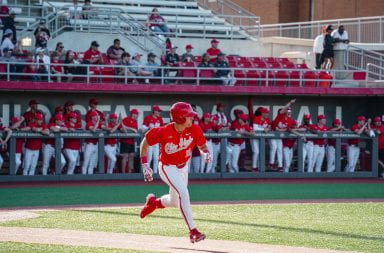
OSU redshirt senior quarterback J.T. Barrett (16) scans the field after a snap during the 2017 Spring Game at Ohio Stadium on April 15, 2017. Credit: Mason Swires | Former Assistant Photo Editor
Since Ohio State redshirt senior quarterback J.T. Barrett arrived in Columbus, he has been taught to avoid interceptions at all costs. Though that mantra remains, co-offensive coordinator and quarterbacks coach Ryan Day has worked with the three-time team captain to increase his throws to contested receivers.
Barrett admitted he hadn’t previously been thinking this way. Last year, Barrett often dropped back, didn’t see anyone wide open and either checked down or scrambled with the intention to run or throw on the run.
But this season, he plans to unload passes even when potential receivers are not as open as he’d prefer.
“(Last year), there’s a guy draped all over my guy, that man’s covered, so I’m not throwing the ball. Whereas now, the mindset is different from the quarterback perspective,” Barrett said.
The signal-caller said Day brought the philosophy to his attention. The coach told him that in the NFL, often no one is wide open, but quarterbacks still have to throw the ball.
“And that’s not throwing the ball into traffic, that’s not throwing the ball foolishly and making poor decisions,” Day said. “But if a guy is covered and contested, where are we throwing that ball where only he can catch it?”
The position coach assured that the importance of minimizing turnovers endures as it has proven it can help win games. But, he intends to have Barrett be “aggressive without being foolish.”
Day, along with co-offensive coordinator and tight ends coach Kevin Wilson, was hired in January to replace former co-offensive coordinators Tim Beck and Ed Warinner who left for jobs at Texas and Minnesota, respectively. He spent the past two seasons working with coach Chip Kelly as the quarterbacks coach for the San Francisco 49ers (2016) and the Philadelphia Eagles (2015).
Though interceptions might be more prevalent as Barrett’s aggressiveness increases, the goal is to further prepare to succeed in matchups against stiffer competition when openings are harder to find.
“Sometimes, they’re going to get us and we’re going to have interceptions, but just try to limit those as much as possible,” Barrett said.
Barrett threw just seven interceptions last year, compared to 24 touchdowns through the air and nine other scores on the ground.
“Last year, when we were playing Clemson, was anybody really just open, running free? Not really, because that’s the top tier in football,” Barrett said.
Former Clemson quarterback and two-time Heisman Trophy finalist Deshaun Watson caught grief for throwing 17 interceptions last season. But, threw for 259 yards against the Buckeyes – along with two interceptions – and 420 yards against Alabama in the national championship. Watson often found success throwing contested passes, relying on his receivers, such as first-rounder Mike Williams, to make plays.
One of the major questions that will determine Barrett’s success with this new philosophy comes from the players who will attempt to catch his passes. The Buckeyes don’t have any receiver with Williams’ experience and natural talent, nor do they have someone like former Ohio State wideout Devin Smith to whom Cardale Jones tossed deep balls.
They don’t even have former H-back Curtis Samuel, who was last season’s top receiver and, at times, Ohio State’s only game-breaking threat on offense.
But, Meyer doesn’t seem worried about finding playmakers.
“The unit is the strongest it’s been since I think the (2014 season),” Meyer said. “Guys just shut their mouth and go really, really hard, and they’re making plays all over the field. They’re very good right now.”
A couple weeks ago, Wilson said that he would like the have eight receivers ready to play, which seems difficult given the roster. Redshirt juniors Terry McLaurin and Johnnie Dixon and sophomores Austin Mack and Binjimen Victor will be among those relied upon to emerge as receiving options, though none of them have caught more than 11 passes in a season.
While the group lacks experience, they must be able to win jump balls and catch passes in suboptimal locations with Barrett’s altered strategy.
“Sometimes they’re going to have to make some catches for you and there’s going to be some ugly throws and it’s not going to be perfect, but the simple fact is you allow those guys to touch the ball and you let them have a chance to go up and make plays,” Barrett said.


